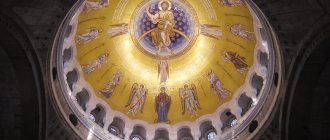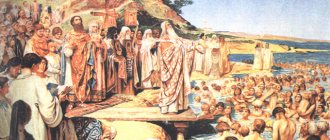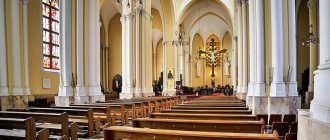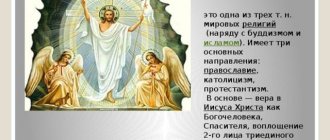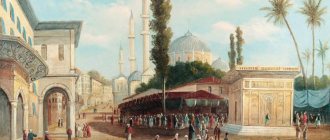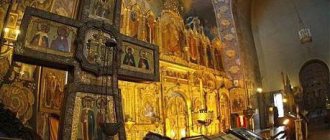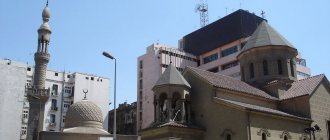Transcript of How Russian Orthodoxy Ended Up Abroad
Contents of the eighth lecture from the course “History of Orthodox Culture”
One of the characteristic features of the history of religions in the twentieth century was their expansion beyond the traditional geographical and ethnic area of distribution. Of course, this is part of the process of globalization, which is so characteristic of the twentieth century and of our time. It must be said that for religions such as Buddhism, this process began in the second half of the twentieth century. But for Orthodoxy and for Russian Orthodoxy, this exit began in the period between the two world wars. However, even before the revolution, through the efforts of Russian missionaries, a kind of basis was created for such an exit of Russian Orthodoxy from its geographical and ethnic borders. Let us briefly outline those regions where Russian Orthodoxy was present before 1917.
In Europe, it was present primarily in the form of diplomatic missions, churches at embassies, churches at the reigning houses of Europe (for the grand duchesses of the Russian dynasty who married European monarchs) or in the form of temple-monuments, such as, for example, at the site of the Battle of the Nations in Leipzig . peoples, or the Battle of Leipzig, is one of the battles of the Napoleonic Wars, which took place in 1813, in which Napoleon I was defeated by the allied armies of Russia, Austria, Prussia and Sweden.. In general, the diplomatic presence in Europe, the church presence, were characterized by somewhat limited contacts with the local population. But large educational projects were often undertaken, usually through the efforts of some individual enthusiasts. For example, Archpriest Alexy Maltsev, who served in Berlin, translated the Orthodox service into German. And of course, priests at diplomatic missions actively maintained interfaith contacts with the corresponding religious traditions in the countries of their stay and served as a kind of liaison between the church authorities in Russia and the corresponding religious traditions abroad.
Things were a little different in Asia and the Far East. First of all, we need to talk about the Holy Land. In this region, which attracted the attention of a variety of powers: England, France, Germany and, of course, Russia, a Russian Palestinian mission was created, more focused on pilgrims. In the Far East, in China, there is a Chinese mission, which after the revolution of 1917 was transformed into dioceses; in fact, it was about preaching Orthodoxy to the local population and about creating a Chinese Orthodox Church. The situation was similar in Japan and Korea. Here, Russian missionaries focused specifically on the local population, actively translating holy books and services into local languages. Moreover, it is interesting that this translation activity concerned not only church, but also secular Russian literature. This was the case, for example, in Japan, where, through the works of Archbishop Nicholas of Japan, the founder of the Russian mission in Japan, a society of translators was organized, which introduced the Japanese public to Russian classical literature - with Turgenev, for example, and so on. Here, already before the revolution, many of the clergy were representatives of the local population - Chinese or Japanese.
Quite a long time ago, until 1917, the Russian Church was present in America. And we are talking not only about the former Russian territory - Alaska - but also about the main part of Canada and the United States. Moreover, it is characteristic that before the revolution, the Russian diocesan structure in North America united all Orthodox peoples - Rusyns, Arabs, Greeks, Serbs, Albanians. Translations into English were also quite actively done here. In fact, the diocese and the American Mission were bilingual.
The revolution of 1917, of course, could not but affect the life of the Russian church abroad. This is characterized by two processes that were relevant for the period between the two world wars. The first process: it was about the separation of territories from the former Russian Empire - Finland, the Baltic states, Poland. And the second process was the formation of a massive Russian diaspora, the so-called first wave emigration. Let's consider these processes in order and first talk about the separated territories. The main trends in the history of the Church in these countries were as follows. The Orthodox turned out to be a minority, but a significant minority - as a rule, second in number after representatives of the titular religion (in one case, Lutherans, in another case, Catholics). And this immediately attracted the attention of the new government authorities to them. The policy of these authorities, whether in Finland, the Baltics, or Poland, was approximately the same. They sought to tear their Orthodox Christians away from Moscow and from the Russian Church. This policy was part of their establishment of a new nation-state. They sought to break all ties, including church and religious ones, that connected them with the former metropolis, with the former imperial center. Therefore, the new authorities actively stimulated the declaration of church independence - autocephaly; pushed local Orthodox Christians to move to the jurisdiction of the Patriarchate of Constantinople - accordingly, to leave the jurisdiction of the Moscow Patriarchate. Autocephaly means, first of all, the self-government of this particular Church: it itself can create its own governing bodies, convene councils, and elect its own primate - the patriarch and metropolitan. But, of course, the dogmatic, doctrinal and ritual side of all Orthodox churches remains more or less unified.
In Estonia, government officials even had the idea of organizing an alliance with the Catholic Church for this purpose. As a result, in the interwar period, national churches emerged - in Finland, in Estonia, and a little later in Latvia. Lithuania occupies a special position here: since for Lithuania it was more important to push away not from Moscow, but from Warsaw, from Poland, they looked rather favorably on the fact that local Orthodox Christians maintained their connection with the Moscow Patriarchate. In addition, pressure on the Orthodox in these countries increased, which followed for different reasons and to varying degrees. In Finland, for example, a calendar problem arose: secular authorities forced the Orthodox to celebrate their holidays and services according to the new calendar, which was not yet accepted by the majority of Orthodox churches. There was a problem of union in Estonia. Probably the most severe situation was developing in Poland: in fact, here, if not bloody, then persecution of Orthodox Christians began, primarily in the eastern parts of Poland, Ukrainian and Belarusian, and the closure and destruction of churches.
Let us now turn to the problem of forming a diaspora. Let us remember that we are talking about approximately one and a half to two million Russian refugees who found themselves outside the borders of the former Russian Empire after the revolution and the Civil War. One and a half to two million are the most common estimates: there are also larger ones, which speak of about five million refugees.
Among Russian emigrants, primarily in Europe, already in 1920 the question arose about the organization of foreign church administration, similar to the one that was created in the territories of the South of Russia cut off from Moscow during the Civil War. This idea of church government on a national basis - only for Russians - in fact, was not entirely consistent with church rules, since church rules recognize, first of all, the territorial principle of the formation of local churches, local church government. Therefore, it would probably be more correct to come under the jurisdiction of the local Orthodox churches - Serbian, Constantinople or Jerusalem. And some representatives of the Russian clergy did so, but the majority took a different path.
In the fall of 1921, the All-Foreign Church Council was held in the city of Sremski Karlovtsi in Yugoslavia and the highest church administration abroad was created, which two years later was transformed into a Synod. This is how the Russian Orthodox Church Abroad, or Karlovac jurisdiction, arose as an independent jurisdiction (after the name of the city where the Synod was originally located, in the interwar period). The first First Hierarch of the Church Abroad was Metropolitan Anthony (Khrapovitsky) of Kiev, a fairly well-known church figure in pre-revolutionary Russia. At the same time, however, part of the emigrant clergy did not recognize this new church formation and remained for the time being under the jurisdiction of the Moscow Patriarchate. Although it must be noted that, of course, the connection with Moscow was now only symbolic.
The ecclesiastical supremacy of Moscow was recognized by French emigrant parishes, parishes in England and part of the parishes in Germany, led by Metropolitan Eulogius (Georgievsky) - at first his residence was in Paris. However, this unity of the parishes of Metropolitan Evlogii with Moscow remained only until 1931. Then, after a conflict provoked by the Soviet authorities with the Moscow church authorities, Metropolitan Eulogius transferred to the jurisdiction of the Patriarch of Constantinople, within the framework of which the Western European Exarchate of Russian parishes was created, and Metropolitan Eulogius became its head, exarch. This is how a division arose in the church emigration into the so-called Karlovites and the so-called Eulogians. In the 1930s, only the Lithuanian diocese, a parish in Paris and several dozen parishes in America remained under the jurisdiction of the Moscow Patriarchate abroad.
How was it in America? After the revolution, the previously unified diocesan structure here split into national entities - Greek, Serbian, Arab. The remaining Russian parishes united into a virtually independent metropolitan district, headed by Metropolitan Platon (Rozhdestvensky). Since 1935, the metropolitan district has recognized a formal connection with the Synod of the Russian Orthodox Church Abroad.
So, the most important difference of the interwar period is the growth of the Russian Orthodox presence in the world. At the same time, in the wake of the formation of a new Russian diaspora, not only the listed church structures arose, but also numerous educational centers, centers of Russian church thought, history, and theology. One of the most famous centers was the St. Sergius Institute, a theological institute in Paris where prominent Russian church leaders: historians, liturgists and philosophers taught. For example, such a philosopher and theologian, thinker as Archpriest Sergius Bulgakov. But there were other centers - in Prague and Berlin. During this period, the presence of this very powerful intellectual component in the Russian diaspora of the interwar period ensured intense philosophical, theological, and cultural contacts between the Russian cultural diaspora and the Western Christian world. In fact, at this moment there was a meeting of the Western world with Orthodoxy as a living religious and theological tradition. At the same time, responding to the challenges of Western philosophy, the Western way of thinking, Russian Orthodoxy itself formulated new theological approaches. This is how, for example, the so-called neopatristic synthesis arose in Orthodox theology in the West, which consisted, on the one hand, in an appeal to a new reading of the fundamental theological texts - the texts of the Holy Fathers, and on the other hand, in an appeal to such categories as religious experience, persona, personality, which were very actively discussed in Western (including religious) thought of that era. Of course, Orthodox theology in the West was much freer than in Russia, and could freely discuss some problems, which could not happen in the USSR.
And the Russian diaspora itself in the interwar period was characterized by intense contacts between the cultural part, sometimes very avant-garde oriented, and representatives of the Church itself. A very striking figure who illustrates this process was the outstanding ascetic, spiritual writer of the Russian emigration, Archimandrite Sophrony (Sakharov). He himself was an artist, part of Kandinsky’s circle in the interwar period, with very intense artistic and ideological searches. And now, in emigration, he experiences a spiritual crisis, which brings him back into the fold of the Church. He not only begins to study at the St. Sergius Theological Institute, listen to lectures by Sergius Bulgakov, but he understands that he wants something more, and leaves for Athos, becomes an Athos monk, where he spends the entire period of the 1930s and 1940s . After the war, he returned to France, and around him a new circle of Europeans of various nations was formed, who were looking for truth in Orthodoxy. And the future Father Sophrony himself was, of course, an excellent example of such contact between the cultural elite of Russia and the church cultural elite. The gap between cultural society and the Church that existed in Russia before the revolution was overcome in emigration after the revolution, and this is very clearly seen in the example of the fate of the same father Sophrony.
After World War II, the situation in the Russian church diaspora changed significantly. During this period, the so-called second wave of Russian emigration was formed. Of the approximately 8.5 million displaced people who found themselves abroad during the Second World War, about 700 thousand became defectors. If the first wave of emigrants preserved their Russianness, dreamed of returning to Russia, to Russia without the Bolsheviks, and of serving it, then the second wave knew what life was like under Soviet rule, and was no longer going to return to the Soviet Union. Their task was to integrate into Western life. Therefore, the first post-war years in emigration were marked by two seemingly opposite processes. On the one hand, there was an expansion of the jurisdiction of the Moscow Patriarchate, the reunification of a significant number of church entities with the Russian Church or the restoration of ties with those with whom this connection was severed during the interwar period. On the other hand, there was an intensification of confrontation between different centers of Russian Orthodoxy - between the Moscow Patriarchate and the Russian Orthodox Church abroad, which naturally fit into the context of the confrontation between powers caused by the Cold War situation.
After the end of World War II, the Orthodox churches of the Baltic states returned to the jurisdiction of the Moscow Patriarchate. The Russian Church restored church ties with the Finnish and Polish Orthodox Churches. In particular, the Polish Orthodox Church, as well as the Czech Orthodox Church, were given church autocephaly - independence. In 1970, the connection with the Russian metropolitanate in America was restored, and it was also given autocephaly - now it is the Orthodox Church in America. The dioceses of the Russian Church of the Moscow Patriarchate were restored in Central and Western Europe and in America.
In encouraging the emergence of independent Orthodox churches, the Moscow Patriarchate was to a certain extent guided by missionary tasks. The emphasis was placed on the creation of local Orthodox churches. And a striking example of such activity was the preaching and organizational activities of London Metropolitan Anthony (Bloom).
Vladyka Anthony was an outstanding Christian preacher. For half a century, with his sermons, conversations, and radio broadcasts, he showed that Christianity can be relevant for modern people, including young people, seemingly very far from religion, but still on a spiritual quest. His words were born from deep personal experience, which he generously shared. And this was also the experience of a person who saw death in the face, the experience of a military doctor, surgeon and participant in the French Resistance during the Second World War. His words were addressed to people of various nations and cultures. They crossed national and religious boundaries. And one more important aspect. His voice was perceived as the voice of the Russian Church - a church that is forced to remain silent. But among its bishops there was a man who spoke and spoke about Christ, that is, about the most important thing in the life of the Church.
The center of the Russian Orthodox Church abroad in the post-war period moved through Germany (Munich) to the United States - to New York. A new educational center was created here - a seminary and publishing house in Jordanville, as well as several monastic centers that preserved the traditions of Russian monasticism. However, the confrontation between the Russian Church Abroad and the Russian Church of the Moscow Patriarchate intensified. In addition to accusations from the Church Abroad of collaboration with the godless government, a new accusation is being formulated. The Moscow Patriarchate was accused of the heresy of ecumenism and impermissible cooperation with Christians of other faiths. Meanwhile - and this is a very important point - personal contacts between representatives of different jurisdictions remained, which ultimately was the key to restoring unity in our days. Because, in fact, there were no significant dogmatic differences between the two directions in Russian Orthodoxy - at home and abroad.
Let us emphasize that it was in the post-war period that the Russian church diaspora acquired global reach. It was no longer only Europe or the Far East, as in the interwar period, but also North and South America, Australia, and Africa. Although Russian Orthodoxy completely disappeared from China, for example, where during the Cultural Revolution the Orthodox Church was virtually destroyed and de facto ceased to exist.
After the fall of the Soviet system, the situation in the church abroad changed once again. The parishes of the Moscow Patriarchate, which by the early 1990s were mainly focused on local residents: Germans, English, French, were again filled with new emigrants - from Russia, Ukraine, Moldova and other former republics of the USSR. This is several hundred thousand people. The ideal of local Orthodox churches, the missionary ideal had to be forgotten for a while - the Russian Church outside the homeland again, as in the interwar period, became mainly emigrant. Only now they were not political refugees, but labor and economic emigrants. The beginning of the 1990s brought a sharp deterioration in relations between the Russian Church abroad and in Russia due to the fact that the Church Abroad attempted to open its parishes on the territory of the USSR. But already in the early 2000s, this conflict came to naught, because the new leadership of the Russian Orthodox Church abroad was not so confrontational towards the Church at home. Thus, there was a tendency towards a rapprochement between the two parts of the Russian Church, which ended in May 2007 with the restoration of their communication. The Russian Orthodox Church Abroad became part of the Russian Orthodox Church of the Moscow Patriarchate.
Let us repeat: the main task of Russian church emigration was to introduce the Western world to the culture, thought and living religious tradition of Orthodoxy, which, in turn, became part of the global trend of the twentieth century towards the emergence of religions from their geographical and ethnic areas.
“The split has already occurred”: the Russian Orthodox Church created two of its own dioceses in Africa at once
The head of the Center for the Study of Problems of Religion and Society at the Institute of Europe of the Russian Academy of Sciences, Roman Lunkin, called the creation of a new exarchate of the Russian Orthodox Church in Africa, consisting of two dioceses, the most important result of the meeting of the Holy Synod held the day before.
The Synod decided to “accept into the jurisdiction of the Russian Orthodox Church 102 clergy of the Patriarchate of Alexandria from eight African countries, according to submitted petitions” and to form from them the “Patriarchal Exarchate of Africa within the North African and South African dioceses.” Archbishop of Yerevan and Armenia Leonid (Gorbachev) was appointed Patriarchal Exarch of Africa. At the same time, no one asked the consent of the Patriarch of Alexandria for such actions on his canonical territory.
“This is important church-political news, which means that the Moscow Patriarchate continues to expand and has not abandoned its global mission, despite the difficult situation in the post-Soviet space, which negatively affects the Russian Orthodox Church,” Roman Lunkin said in an interview with Reedus.
According to the religious scholar, on the one hand, the expansion of missionary service is a natural process for any Church, but in this case it occurs in the context of the confrontation over Ukraine between Moscow and the Patriarchate of Constantinople, as well as other local Churches that support it.
“The Orthodox world was split, as a result, local Churches found themselves in new conditions, and the Russian Orthodox Church began to develop in Western Europe, Southeast Asia, and now in Africa. Work had been carried out there before, but the scale was much more modest. One hundred priests in Africa at once is a fairly large figure; it approximately corresponds to the average number of priests in Russian dioceses. A very good start for the African mission. This continent is often underestimated, and there are already millions of Orthodox Christians there, along with Catholics and Protestants,” Lunkin noted.
Previously, the Russian Orthodox Church had only a few parishes in Africa, and they reported directly to Patriarch Kirill through the Moscow Patriarchate Office for Foreign Institutions. Among them is a church in honor of St. Sergius of Radonezh in South Africa, a church in honor of the Great Martyr Demetrius of Thessalonica in Cairo, and one more parish each in Tunisia and Morocco.
In addition, a small number of African parishes belong to the Russian Orthodox Church Outside of Russia and the Archdiocese of Orthodox Churches of the Russian Tradition in Western Europe - self-governing Churches within the Moscow Patriarchate, which by their very existence significantly expand its geography.
Patriarch Theodore II of Alexandria lost a hundred priests at once © Press service of the Patriarch of Moscow and All Rus'
As a result of the formation of the Exarchate of Africa, the Russian Orthodox Church increased its presence on the continent several dozen times. Thus, Moscow encroached on the canonical territory of the Alexandrian Orthodox Church, relations with which are currently clouded by its participation in the Ukrainian schism.
Despite the long and friendly relations with Patriarch Kirill, Patriarch Theodore II of Alexandria recognized the Orthodox Church of Ukraine, created on the initiative of ex-President Petro Poroshenko, thereby supporting the Patriarchate of Constantinople, and not Moscow.
“This may cause discontent in other Churches, but to those who criticize the Russian Orthodox Church and Patriarch Kirill for such decisions, we can only say that a split in the Orthodox world has already occurred, so preaching throughout the world is the best and most natural thing that can happen. The Russian Church is advancing its world mission despite secular politics and crises that are likely to isolate Russia,” concluded Roman Lunkin.



